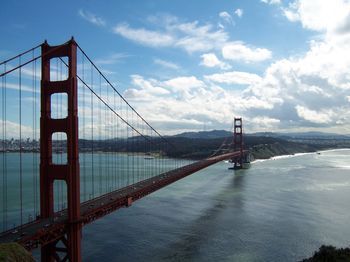The Golden Gate Bridge - History and Facts
From the moment city of San Francisco was formed it had a constant need to establish permanent transport routes with neighboring cities. One of the most crucial ones was connection to Marin Country, which is located north of the city across the bay of San Francisco. Organized transport across the bay started in 1820 with ferry service that soon became one of the largest ferry services in the entire world. With the daily transport of passengers, goods and most importantly fresh water, commercial enterprises soon came to realize that building permanent bridge in the area could enable city to grow like never before.
Long journeys with ferries (27 minutes for 2km trip across the strait) and ever increasing need for fresh water soon forced creation of concrete bridge building plans. Even though many architects claimed that bridge could never be built in this location, or that it would cost almost astronomical sums of money. One designer who provided solid and most importantly relatively cheap plans was Joseph Strauss, ambitious American structural engineer who showcased to the public his design that took advantage of newly discovered advanced materials – most notably steel.

Strauss's initial plans called for construction of two massive cantilevers on each side of the straight, connected by a central suspension segment which would hold deck in the air. To bring his dream into reality, Strauss started 10 year-long crusade, fighting against opponents at his every step – government officials asked for several consultation from other bridge building experts, military demanded open passage through straight of San Francisco at all times, Southern Pacific Railroad company protested and lobbied fiercely in fear of losing their lucrative ferrying business, unions asked for constant guarantees for the favoring of local workforce, end so on. In the end, by January 1923 all obstacles were solved and official preliminary discussions for building Golden Gate Bridge started. Because Strauss himself did not have much architectural knowledge, he focused only on broad engineering and construction problems. Design of the bridge itself was done by three engineers - Irving Morrow designed the bridge itself to fit in Art Deco style, senior engineer Charles Alton Ellis provided his expertise and designer Leon Moisseiff created final design of graceful cable suspension.
Construction of bridge started on January 5 1933, several years after original schedule (Wall Street Crash of 1929 caused 3 year delay) and with the budget of 35 million dollars. The main construction company of the bridge was McClintic-Marshall Construction Co, but in reality more than 10 subcontractors worked on bridge for the period of 4 years. Trough he entire period of construction Joseph Strauss remained head of project, overseeing day-to-day work.
Golden Gate bridge was officially opened on 27 27, 1937, with one week long festivities and crossing of 200 thousand pedestrian visitors. In 1987, 50th anniversary of bridge construction attracted much larger crowds, with over almost 1 million people visiting San Francisco and its iconic bridge. During celebration 300,000 people walked over center span of the bridge, causing it to flatten slightly (engineers calculated that bridge experienced only 40% of its maximum load).
